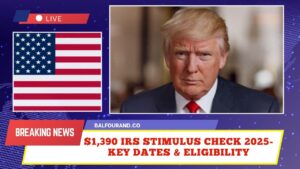With inflation continuing to stretch household budgets, the U.S. government has confirmed that stimulus checks between $300 and $1,700 will be issued across several states in 2025.
These one-time payments are aimed at providing financial relief to low and middle-income families, seniors, and those receiving federal assistance like SSI, VA, or Social Security.
Here’s everything you need to know about the eligibility, payment amounts, and when you’ll receive your stimulus check.
What Are the $300–$1,700 Stimulus Checks?
Stimulus checks are direct cash payments provided by state and federal governments to ease the burden of rising costs. This new round of payments will help Americans cover essential needs like food, rent, utilities, and healthcare.
The payments are either:
- Flat-rate: Same amount for all eligible recipients.
- Scaled: Amount varies based on income level and family size.
Who Is Eligible for the Stimulus Check?
Eligibility differs by state but typically includes:
- Low or moderate-income individuals and families
- Recipients of EITC (Earned Income Tax Credit)
- Social Security, SSI, or VA beneficiaries
- Those who filed taxes in 2018 or later
- Residents of states participating in the program
Check your state revenue department or benefits portal for specific requirements.
How Much Will You Get?
Payment amounts vary depending on your state, family size, and income bracket. Some states issue flat payments, while others use sliding scales.
| Family Type | Estimated Payment Amount |
|---|---|
| Single adult | $300 – $500 |
| Couple without children | $500 – $1,000 |
| Family with two children | $1,200 – $1,700 |
| SSI/VA/Social Security users | $400 – $1,000 |
Payment Timeline: When Will You Get the Money?
Most participating states will begin issuing stimulus payments between summer and fall of 2025. Direct deposit recipients will receive funds faster, while paper checks or prepaid debit cards may take a few extra weeks.
How to Receive Payment Faster
- File your 2024 taxes early
- Choose direct deposit on tax forms
- Keep your mailing address and bank details updated with the IRS or your state agency
How to Apply or Check Your Status
Automatic payments will go to those already receiving:
- OAS
- SSI
- Social Security
- VA or EITC-related support
If You Don’t Receive Federal Aid:
You may need to apply manually via your state’s official site.
To check your stimulus payment status:
- Visit the IRS “Where’s My Payment” portal or your state’s revenue department
- Have your Social Security Number (SSN), address, and tax filing year ready
Stimulus Payment Overview
| Specification | Details |
|---|---|
| Amount | $300 – $1,700 |
| Eligible recipients | Low-income, SSI, EITC, VA, etc. |
| Delivery method | Direct deposit, check, debit card |
| Funding source | State and federal funds |
| Payment schedule | Summer–Fall 2025 |
| Application required | In some states |
Avoiding Stimulus Check Scams
Be alert—fraudsters are targeting stimulus check recipients. Stay protected by following these tips:
- Never share your bank information over the phone or email
- Government agencies will not ask for money to release a check
- Always use official government websites for updates
- If someone threatens or pressures you for information—hang up immediately
The $300–$1,700 stimulus checks coming in 2025 are part of a nationwide effort to support those affected by rising costs.
With varying eligibility and payment structures by state, it’s important to check your local guidelines. File your taxes, verify your information, and ensure you’re ready when your state releases the funds.
FAQs
What if I didn’t file taxes recently—can I still get a payment?
Yes, in some states, you may still be eligible based on other benefits like SSI or VA. Filing taxes helps verify your income.
Will I be taxed on the stimulus payment?
No. These stimulus checks are tax-free, and you will not owe any additional tax on them.
Do I need to apply for the check?
Only if you’re not already receiving qualifying benefits. Most eligible recipients will get the payment automatically.




